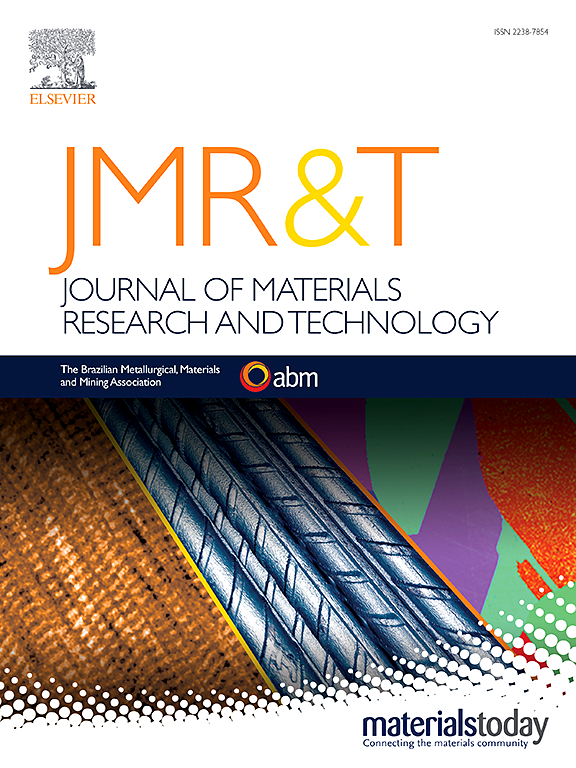A combined experimental and numerical assessment of the role of microsegregation and phase formation on hot cracking susceptibility in laser powder bed fusion processed CM247LC
IF 6.2
2区 材料科学
Q1 MATERIALS SCIENCE, MULTIDISCIPLINARY
Journal of Materials Research and Technology-Jmr&t
Pub Date : 2025-06-09
DOI:10.1016/j.jmrt.2025.06.040
引用次数: 0
Abstract
For many high-performance alloys originally developed for the casting route, hot cracking is a serious problem in the Laser Powder Bed Fusion (PBF-LB/M) process and limits the use of e.g. high-γ′ nickel-based alloys such as CM247LC in additive manufacturing. In this work, we investigate the relationship between PBF-LB/M processing parameters and the solidification path, i.e. phase formation and microsegregation, and its potential impact on hot cracking for the high-γ′ alloy CM247LC. We combined experimental microstructural analysis using scanning and transmission electron microscopy, atom probe tomography and diffraction techniques with multiphase-field simulations on μm scale. Process simulations at mesoscale of the melt pool provide the link between the process conditions and the thermal boundary conditions for the microstructural simulations. The study confirms the appearance of carbides, borides and γ′-precipitates in the as-solidified microstructure. The quantity and particle size of these phases as observed in the experimental samples, are in qualitative agreement with the simulation results. Therefore, the simulations can be used to elucidate and quantify the differences in the solidification path for different thermal process conditions. Although the comparison of samples processed with high energy density (cooling rate 65,000 K/s) with those processed with low energy density (cooling rate: 570,000 K/s) show large differences in the crack density observed in the experiments, the microstructural differences and the phase formation at the dendritic scale do not show any remarkable qualitative or quantitative differences. The correlation between processing conditions, microstructure evolution and crack formation is critically discussed and differences to the current understanding presented in existing literature are identified.
显微偏析和相形成对激光粉末床熔合CM247LC热裂敏感性影响的实验与数值结合研究
对于最初为铸造路线开发的许多高性能合金,热裂纹是激光粉末床熔合(PBF-LB/M)工艺中的一个严重问题,并且限制了高γ′镍基合金(如CM247LC)在增材制造中的使用。本文研究了PBF-LB/M工艺参数与高γ′合金CM247LC的凝固路径(即相形成和微偏析)之间的关系及其对热裂的潜在影响。我们将扫描电镜、透射电镜、原子探针层析成像和衍射技术与μm尺度的多相场模拟相结合。熔池中尺度过程模拟为微观结构模拟提供了过程条件与热边界条件之间的联系。研究证实了凝固组织中碳化物、硼化物和γ′相的存在。在实验样品中观察到的这些相的数量和粒度与模拟结果在定性上一致。因此,模拟可以用来阐明和量化不同热处理条件下凝固路径的差异。虽然高能量密度(冷却速度为65000 K/s)与低能量密度(冷却速度为570000 K/s)试样在实验中观察到的裂纹密度差异较大,但在枝晶尺度上的显微组织差异和相形成没有明显的定性和定量差异。本文批判性地讨论了加工条件、微观结构演变和裂纹形成之间的关系,并指出了与现有文献中提出的当前理解的差异。
本文章由计算机程序翻译,如有差异,请以英文原文为准。
求助全文
约1分钟内获得全文
求助全文
来源期刊

Journal of Materials Research and Technology-Jmr&t
Materials Science-Metals and Alloys
CiteScore
8.80
自引率
9.40%
发文量
1877
审稿时长
35 days
期刊介绍:
The Journal of Materials Research and Technology is a publication of ABM - Brazilian Metallurgical, Materials and Mining Association - and publishes four issues per year also with a free version online (www.jmrt.com.br). The journal provides an international medium for the publication of theoretical and experimental studies related to Metallurgy, Materials and Minerals research and technology. Appropriate submissions to the Journal of Materials Research and Technology should include scientific and/or engineering factors which affect processes and products in the Metallurgy, Materials and Mining areas.
 求助内容:
求助内容: 应助结果提醒方式:
应助结果提醒方式:


